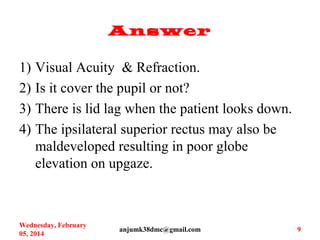Ospe (objective structured practical examination)
- 1. OSPE (Objective Structured Practical Examination) Dr Md Anisur Rahman (Anjum) [email protected] 01711-832397 Wednesday, February 05, 2014 [email protected]
- 2. OSCE • Objective: Examiner use a check list forObjective: Examiner use a check list for evaluating the trainee.evaluating the trainee. • Structured: Trainee sees the same problemStructured: Trainee sees the same problem and perform the same tasks in the same timeand perform the same tasks in the same time frame.frame. • Clinical: The tasks are representative of thoseClinical: The tasks are representative of those faces in real clinical situation.faces in real clinical situation. Wednesday, February 05, 2014 [email protected] 2
- 3. Modification of OSCE • OSER: Objective Structured Examination Record. • OSPE: Objective Structured Practical Examination. • OSVE: Objective Structured Video Examination. • OSPRE: Objective Structured Performance Related Examination. Wednesday, February 05, 2014 [email protected] 3
- 4. 1. History taking (Congenital cataract/ Cataract in Children) • History: • When was white reflex noted? • Congenital cataract in the family– sibling history. • Trauma/ child abuse • Redness, pain before cataract. • Behavioral pattern of child at home, school. • Visual status – ambulation in familiar & unfamiliar surroundings. • School performance, especially reading. Wednesday, February 05, 2014 [email protected]
- 5. 1. History taking (Congenital cataract/ Cataract in Children) Birth History: H/O consanguinity. Maternal infection especially 1 st trimester. Gestational age. Birth weight. Birth trauma, unwanted event during delivery. Supplemental oxygen therapy or being kept in incubator Developmental anomalies. Developmental milestone. Wednesday, February 05, 2014 [email protected]
- 6. 2. History taking R.P Age of onset of symptoms. Duration of night blindness. Duration of progressive loss of visual field. Duration of dimness of vision . Is it progressive? Family history of R.P. H/O consanguinity. H/O trauma. H/O drug intake. H/O hearing disorder, ataxia, nystagmus. Wednesday, February 05, 2014 [email protected]
- 7. 2. History taking R.P • H/O mental retardation. • H/O heart disease. • H/O hypogenitalism, obesity, polydactyly. • H/O diarrhea, skeletal deformity. Wednesday, February 05, 2014 [email protected]
- 8. Question Wednesday, February 05, 2014 [email protected] 8 Q1) Here is a child with ptosis since birth. What would be the most important examination? Q 2) By seeing of which point you will decide to early surgery? Q 3)How could you decide clinically if this child's ptosis is caused by a dystrophic levator? Q 4) What other ocular sign may be present? And why?
- 9. Answer 1) Visual Acuity & Refraction. 2) Is it cover the pupil or not? 3) There is lid lag when the patient looks down. 4) The ipsilateral superior rectus may also be maldeveloped resulting in poor globe elevation on upgaze. Wednesday, February 05, 2014 [email protected] 9
- 10. Question A patient who is about to undergo cataract surgery has the following results during her pre-assessment. Axial length = 23.00 mm K1 = 42.00 DS K2 = 44.00 DS A-constant of the lens to be used = 118.0 Wednesday, February 05, 2014 [email protected] 10
- 11. Question a. Calculate the lens power needed to achieve emmetropia. b. During the operation, the patient has a large ruptured posterior capsule and you decide to fit the lens in the sulcus. Would you use a lens (same A-constant) with a higher or lower power compared with a? Wednesday, February 05, 2014 [email protected] 11
- 12. answer a) Using the IOL formula P = {A - 2.5 x (axial length) - 0.9 x (average K reading )} = {118 - 2.5 (23) - 0.9 (43)} = 21.8 D ( As the lens come in step of 0.5 D, the one used would be 22.0D) b) Moving the lens forward increases the power of the lens and therefore a weaker lens is needed. This is usually 0.5D less than in the bag IOL Wednesday, February 05, 2014 [email protected] 12
- 13. Question • A patient has a visual acuity of 6/6 in both eyes while wearing glasses with the following prescriptions: • OD -1.00/-0.50 X 90 OS -2.25 / -1.75 X 180 • The keratometry reveals the following results: • OD 7.85 mm along 1800 (43.00D) 7.85 mm along 900 (43.00D) • OS 7.80 mm along 1800 (43.25D) 7.50 mm along 900 (45.00D) Wednesday, February 05, 2014 [email protected] 13
- 14. Question • 1) Which structure contributes to the astigmatism in the • a. right eye? b. left eye? • 2. If the patient were to wear spherical hard contact lenses, which eye will see better • Wednesday, February 05, 2014 [email protected] 14
- 15. Answer 1) a) The lens • b) The cornea. Total ocular astigmatism= corneal astigmatism + lentricular astigmatism. • 2) The left eye. A hard contact lens can neutralize about 90% of corneal astigmatism. Therefore the left eye will see better than the right eye as the astigmatism in left eye is entirely corneal. • • Wednesday, February 05, 2014 [email protected] 15














